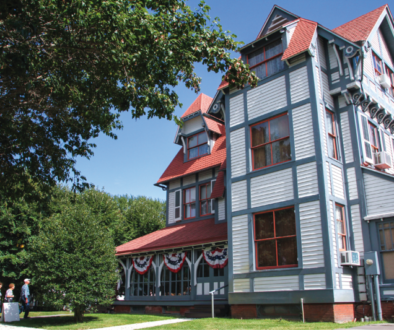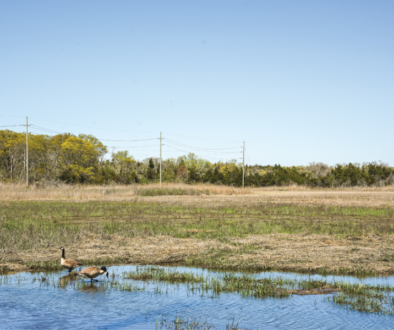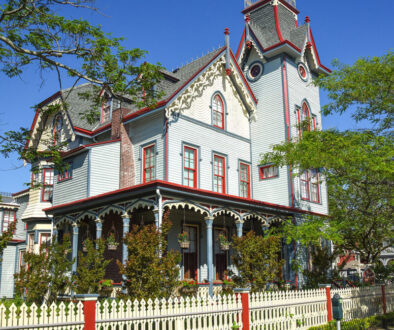A Marsh Runs Through It
We take you on a visit to the Sperlak Gallery & Sculpture Garden

In the movie Good Will Hunting, there is a pivotal scene that takes place between Robin Williams and Matt Damon on a park bench where Williams’ character Sean Maguire, a street-wise Boston psychologist, is trying to explain to Will, the eponymous young genius, the difference between knowledge gained from a book and the deeper knowledge that can only be acquired by throwing yourself into the occasionally messy experiences of real life. He tells him, “If I asked you about art you’d probably give me the skinny on every art book ever written…but I’ll bet you can’t tell me what it smells like in the Sistine Chapel. You’ve never actually stood there and looked up at that beautiful ceiling.”
When it comes to appreciating art, the reproduction is often simply a poor substitute for experiencing the work in person. The facsimile never lives up to the reality; the print cannot express the energy, vibrancy, or charm of the original, and so it is with the farm, home, workshop and in fact, the art of Stan Sperlak. It is a thing you need to experience in person to truly appreciate and Stan, a Cape May County artist, horticulturist, retired landscape architect, and raconteur, just may represent this concept better than most.
Born in Denver, Colorado in 1960, Stan spent some of his early years traveling throughout America as the son of a U.S. Coast Guardsman. His family was from South Jersey and returned here constantly and he eventually completed most of his primary and secondary education here.
Stan’s love of plants began as a child living in Hawaii, and continued through adulthood, eventually leading him into a career as a landscape architect and horticulturist.
For 34 years he tended the yards and gardens of some of the wealthiest homes in Cape May County, where he gained a reputation for his unique approach to design and sustainability. He found in landscape design a confluence of passions—his love of drawing, the natural world, and plants—which eventually led him to enroll in the Pennsylvania Academy of the Fine Arts. There he met two people who would be instrumental in his development as an artist.
“While I was studying at the Academy, I met a guy named Bill Frederick,” said Stan. “I had already owned his book and when I saw that he was in my class, I thought, well this is very interesting, here’s the famous landscape architect, and he’s in my painting class.”
William Frederick was an accomplished landscape architect and horticulturist who, among other things, was a longtime board member of Longwood Gardens and its first president. He owned a place he called Ashland Hollow, a 28-acre stream-fed plot in the Brandywine River Valley that features a 17-acre garden, a decades-long source of study and inspiration for him until his death in 2018, and it became a source of inspiration for Sperlak as well.
“He invited me up to his property to paint there with several of the other students. He had entertained guests like Thomas Church from California and Roberto Burle Marx from Brazil, who had come to his property to discuss the heights of landscape theory and design, and here he was telling us that gardens need destinations, that they need places to get lost in, and to loop in. That the idea of shoving plants up against a house was pedestrian and detracting to a sense of place. So, he got me thinking about this whole idea of moving the landscaping away from the house and creating pathways and gardens. Also, there were always things on his property that were named, like there was The Loft and The Stairs, The Summer Garden or The Winter Garden, and I started to do these kinds of things on my client’s properties.



“At the same time, my other inspiration was the painter Pat Witt. In her backyard in Millville, she has a bamboo grove with trails through it, a pond and these old, stone columns from Millville City Hall—from when they tore it down—and they’re lying around her yard like Roman ruins.”
“So spending time with both of those people and seeing how interesting it was to have artifacts laying around your property, and special benches and places to sit, and places where there’s a perfect view, or a distinctive fragrance, or some sort of detail that makes it interesting, well…I was hook, line and sinker, ready to do that with my own property. That was 20 years ago, and there has been at least 20 years of work since then to get this property to look the way it does today.”
In 1997, Stan established Crow Creek Farm after buying a 37-acre parcel of land in Goshen that was originally part of the Ludlum Farm, one of the last salt hay farms on the peninsula.
“It was an escape from my busy life living and working in the middle of two busy roads in Cape May Court House,” says Stan. “It was starting to become unbearable. So this was like a safety valve for the future. A place I could own, where I might build a house, or move my business to. This became an opportunity.”
Stan explains that when he first set eyes on the property it was the middle of March and the land was quiet and serene, but by the time he took ownership of it, it was May and the height of spring insects with gnats, strawberry flies and mosquitoes swarming the marshes. He wondered quietly if he’d made a massive mistake.
The battle to reclaim the property was as much about returning it to a more natural state as it was removing all the artificial debris that had piled up over the years. There were fences all over that had been infested with roses and vines, weren’t functional anymore, and needed to come down. There were breeding grounds for mosquitoes, trees that had fallen over, so he took upon himself to clean up the property and get rid of a lot of stuff that had been dumped there for decades.
At first, he used the farm simply as his own refuge and playground. He would sleep there in a converted garage apartment, paint the beauty he found there, and explore the land. “When I was first putting a little addition on top of my converted garage, I stood on the roof one day and realized that if I was to take two trees down in this one little section of woods, I could see all the way to the Delaware Bay, and from the other direction, I could see all the way to Crow Creek,” said Stan. “It made me realize that if I just managed the property with some very small, surgical strikes, I could create amazing views while keeping the natural state of the land.”

Stan had been teaching outdoor, landscape painting workshops on the farm since 2002, and had run out of patience trying to find places where he could take students to paint outdoors without fighting the rain, wind, bugs, heat or chill. He fooled around with the idea of building some sort of shelter on the farm, but then worried that the artists would always have the same view, so abandoned that. It was then that he switched to the idea of building a studio that he could use not only for his own art, but for instruction.
“I had spent a couple of years staying here at the farm in my small garage apartment, trying to figure out where my three-bedroom house would be with my four car garage, what my views would be, and I started thinking all these super, overblown thoughts—the trophy house idea. I had worked on so many homes on the islands that I began thinking, ‘It’s my time to have a house like that.’ But as I started to get prices to build anything like that, even stripped down, it scared the stuffing out of me, and I thought, ‘You know, I’m never going to be able to really afford something like that’ and at the same time started thinking, ‘and you know what, I don’t even really need it.’”
He dropped the idea of building a house and instead began thinking about building a barn that could second as a studio. It was originally intended to have an area for the tractors to park in it, possibly wine-making facilities, with a portion of it to use as a workshop space.
“I approached my good friend and neighbor Jamie Hand, who is an artist himself, a world-famous duck decoy craftsman. He also happens to be into restoring 17th- and 18th-century homes and barns, so I asked him about advising me to build my own. I figured I had the men and the tools. Maybe I could do it myself.”
Hand’s advice sent him in another direction. “Jamie told me, ‘I can’t help you build a barn—you’ll never build it the way the Amish will build it. I’ll give you the name of these Amish guys, they’ll come down, build the whole thing in a week and you’ll have everything you want.’”
“Not only was he right, but they were also a third of the cost of anybody else,” says Stan. “The craftsmanship, the design, the look, and the feel were everything I wanted. It was absolutely unique.”
Today Crow Creek Farm is home to The Sperlak Gallery & Sculpture Garden, which opened last year as a sort of pre-trial run. This year will be the first full year of operation.
After years of building a following as a public figure through his art, his workshops and social media, people began to recognize the relationship between Stan the artist and the farm. They would come to the farm for a workshop, or a private event, and they would take pictures and post them to Facebook or Instagram.
“There became this sort of a mystique about Crow Creek Farm and a lot of people would ask me, ‘What do you have to do to get invited to your property?’ I would tell them to take a workshop or just give me a call. I don’t mind visitors. And people would do just that. But when I ended my 13-year relationship with Soma Gallery in Cape May because I decided that I really wanted to represent myself, in my own gallery, on my own property, I got the idea that maybe I could combine all my passions into one thing.”

Stan figured that a lot of people who would come visit the Gallery would also be interested in touring the property, so the Sperlak Gallery & Sculpture Garden was born, evolving from a semi-private affair to a semi-public one.
“A lot of the inspiration behind the farm has to do with my heritage,” says Stan. “Both my parents came from large families and there were always lots of people around. Maybe it was due to my isolation as a child, but I enjoy people. A lot of people think artists always want to be left alone, but that’s a myth, at least with me. I like people. I like looking at the stars, watching the sky turn colors, seeing the grass grow, the seasons change, and the weather come across the bay. I’m still that kid, fascinated by plants, curious about the world and eager to show you a unique piece of bark. I find it interesting and my hope is that other people do too.”
Of the 37 acres on Crow Creek farm, roughly 20 of them are walkable, accessible via mown thoroughfares, mulched paths, bridges, and walkways. Sprinkled throughout are the sculptures, but they are a bit different from what you might expect to see in place like the Grounds For Sculpture in Hamilton, NJ. Stan’s philosophy had always been “low-cost/no-cost” with many of the pieces being things that people have given him such as rocks, iron pieces, a steel ball, reclaimed lumber, and things that he’s acquired for $10 or $20. These are often more whimsical in nature, and not always obvious. Each piece has a story or a bit of intrigue that Stan shares if he’s giving a tour, but he says he’s also learned that people are more than capable of making up their own stories regardless of whether he is with them or not—which has given him more confidence in both the nature of the Gardens and in human nature.
“Many of the things I found in the woods here. Giant logs that had interesting shapes to them, and that we stood up. Old farm implements that we drug out from between the trees. I’ve traded paintings for some rocks—talk about Jack and the Beanstalk. A local sod farmer from Eldora had been piling up these rocks that he kept hitting with his tractor, lying just below the surface. I asked the guy if I could have them and he said, ‘What are you going to do with those big rocks?’ The thing is, they might not have been worth anything to anyone else, but they found a home here.”
As you walk the property, some of the pieces appear prominently, designed to be exposed or silhouetted against the sky, painted bright colors, or purposely out of place. Others are much more subtle, blending in unless you’re paying attention. After a while, everything begins to look like a planned sculpture. You begin to wonder if that log was an accident or put there by Stan and his cadre of volunteers.
“As you get a little older,” Stan says, “you find certain things more dear, especially simple things, that maybe other people don’t get. For me, the bark of a different tree was enough to make me want to say, ‘Hey, I want to you to come and see this tree I found in the woods, it’s got the coolest bark’ and people would come with me, and along the way we’d have to step across this and that and before they knew it, they were drawn in, too.”
Stan walks around the property twice a day most days, weather permitting. Along with his trusty companion, a two year old Bassador (half Bassett Hound and half Labrador) named Eli, he takes the long way to get the mail in the morning, and then a different route each night to watch the sunset, maybe enjoy a glass of wine, think about life and possibly chase a rabbit or two.
“Someone sent me a letter the other day,” Stan tells me before I leave. “An 18-year-old budding scientist actually—I want to show it to you.”
It is a letter thanking Stan for his generosity and curiosity and ends with this: ‘We artists, we surrealists who change the world, who have an impact, and give people hope and a greater enjoyment for life. For what more does the eye crave than beauty? All we can hope for is that our voice will be loud enough, that our work will be influential, and that all the truth that we extract from life will rain down on us and be torrential. I’m glad we’re friends, there’s not many people that I know that desire so badly to show the world the beauty that we see and create, but it is the best ambition a man can have.’”
South Jersey is an endlessly fascinating and beautiful place, but beyond the obvious landmarks, towns and beaches, are the hidden treasures, secluded destinations and places shrouded in mystery. You can read about them of course, just like Matt Damon’s boy genius from Southie. But like Stan’s paintings themselves, if you really want something you can take with you, you owe it to yourself to experience this quiet sanctuary in the village of Goshen and discover what inspires him in the first place. Breathe in the salt air, watch the light dance over the fields, and hear the birds cry out. Then if the spirit moves you, you can purchase a glimpse of his life here, a work of art inspired by the forests, meadows, wetlands and painted skies of his own backyard—where a marsh runs through it.



